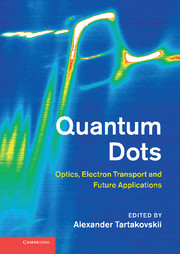Book contents
- Frontmatter
- Contents
- List of contributors
- Preface
- Part I Nanostructure design and structural properties of epitaxially grown quantum dots and nanowires
- 1 Growth of III–V semiconductor quantum dots
- 2 Single semiconductor quantum dots in nanowires: growth, optics, and devices
- 3 Atomic-scale analysis of self-assembled quantum dots by cross-sectional scanning, tunneling microscopy, and atom probe tomography
- Part II Manipulation of individual quantum states in quantum dots using optical techniques
- Part III Optical properties of quantum dots in photonic cavities and plasmon-coupled dots
- Part IV Quantum dot nano-laboratory: magnetic ions and nuclear spins in a dot
- Part V Electron transport in quantum dots fabricated by lithographic techniques from III–V semiconductors and graphene
- Part VI Single dots for future telecommunications applications
- Index
- References
3 - Atomic-scale analysis of self-assembled quantum dots by cross-sectional scanning, tunneling microscopy, and atom probe tomography
from Part I - Nanostructure design and structural properties of epitaxially grown quantum dots and nanowires
Published online by Cambridge University Press: 05 August 2012
- Frontmatter
- Contents
- List of contributors
- Preface
- Part I Nanostructure design and structural properties of epitaxially grown quantum dots and nanowires
- 1 Growth of III–V semiconductor quantum dots
- 2 Single semiconductor quantum dots in nanowires: growth, optics, and devices
- 3 Atomic-scale analysis of self-assembled quantum dots by cross-sectional scanning, tunneling microscopy, and atom probe tomography
- Part II Manipulation of individual quantum states in quantum dots using optical techniques
- Part III Optical properties of quantum dots in photonic cavities and plasmon-coupled dots
- Part IV Quantum dot nano-laboratory: magnetic ions and nuclear spins in a dot
- Part V Electron transport in quantum dots fabricated by lithographic techniques from III–V semiconductors and graphene
- Part VI Single dots for future telecommunications applications
- Index
- References
Summary
Introduction
Self-assembled quantum dots (QDs) have been at the center of research on the quantum properties of zero-dimensional semiconductor nanostructures. The deep understanding of the physical properties and mechanisms that are active in QDs have allowed for their application in quantum secure single photon communication, quantum processing, etc. This would have been impossible without the progress in the growth control of self-assembled QDs. Nowadays, we can accurately control QD parameters such as height, composition, and strain which determine the optoelectronic and spintronic properties. Several double capping approaches have been developed that allow trimming of the QD height and Sb capping was shown to eliminate QD erosion during capping. Droplet epitaxy is a novel approach to obtain non-strained QDs, which is of great advantage because strain is one of the most complicating factors in understanding and utilizing self-assembled QDs.
In this chapter we will review our recent cross-sectional scanning tunneling microscopy (X-STM) analysis of self-assembled QDs in various hosts and obtained by a range of techniques to control their structural properties. The X-STM technique allows to image atomic scale details in semiconductor structures that are cleaved along a natural cleavage plane perpendicular to the growth direction. Although we have been able to analyze many intricate aspects of the studied QDs by X-STM, this technique is limited by its twodimensional (2D) nature. Recently, atom probe tomography (APT) has been able to extend its field of application to semiconductor materials.
- Type
- Chapter
- Information
- Quantum DotsOptics, Electron Transport and Future Applications, pp. 41 - 60Publisher: Cambridge University PressPrint publication year: 2012



